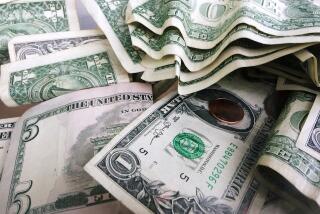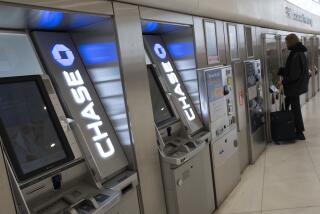Banks Pushing Hard to Boost Online Payments
- Share via
After a decade of largely failing to get their customers to pay bills via computer, America’s banks are stepping up the pressure. And the reason isn’t because they can save money that way, but because they hope to keep their best customers and sell them an array of new services.
Last week’s announcement by three major banks that they had formed a consortium to develop online bill-presentation standards underscored the banks’ growing commitment to moving more transactions to the Internet.
It also highlighted a determination by the banks to retain their influence over people’s financial lives.
Americans received more than 18 billion bills last year--and the organizations that sent out those bills spent some $17 billion on postage. Moving many of those payments to the Web or other electronic systems could cut those costs by more than half, analysts say.
More important for banks, however, is that online bill-paying gives them more opportunity to pitch services and products to customers via their Web sites. That opportunity outweighs a little-known fact about online banking: For a variety of reasons, it doesn’t save the banks much money.
For one thing, more than half the time bills are paid online, the bank still has to cut a physical check and send it to the biller by mail. A decade from now, banks will have to maintain both the electronic bill payment and traditional check-payment options.
Bankers also say the cost of the electronic gear needed for online bill-paying far outstrips the interest the banks earn from “playing the float.” Banks charge customers’ accounts for an electronic payment the day the customer orders it sent out, but continue earning interest on the money until it arrives at the biller’s office.
People likely to pay their bills online tend to be highly valued customers; they have higher incomes and net worth. Banks view online bill payment as a way to attract these people to their Web sites, where they might advertise insurance, brokerage or other services.
Yet banks have been unable to persuade most customers to pay their bills online. Fewer than 2% of bills are paid that way.
Part of the reason is that banks give customers little incentive to try the new service. Most banks still charge for electronic bill-paying or impose potentially onerous requirements for free service.
Bank of America, for example, requires customers to directly deposit their paychecks or keep a $10,000 balance in order to avoid a $5.95 monthly fee for online bill-paying, while Wells Fargo charges $5 a month unless customers maintain a combined balance of $5,000 in checking and savings accounts.
Even more discouraging, analysts say, is that most customers still receive their bills by mail.
“The missing ingredient to get consumers to the banks’ Web sites has been content,” said Michael Killen, president of the Palo Alto research firm Killen & Associates. “That’s what bills are, content.”
Online bills would guarantee that customers would return to their banks’ Web sites at least once a month, giving the banks regular opportunities to market a variety of products in a highly interactive environment.
Online bill delivery might wean more customers from their habit of paying by check.
“It’s mostly inertia,” said David Medeiros, group director of Tower Group, a banking technology consulting firm.
“The banking industry certainly makes it easy to pay by check; the Federal Reserve System makes it easy and affordable. You’re talking about the inertia of getting people away from that. Do I really save that much online versus putting it in the mail? No.”
On the other hand, “If you start to get your bills electronically, it’s the natural next step to pay it electronically,” said Bruce Luecke, executive vice president of online banking for Bank One.
The consortium formed last week by Chase Manhattan, First Union and Wells Fargo, temporarily called the Exchange, will develop standards for the online presenting of bills by companies such as utilities, mortgage lenders and telephone service providers
The Exchange will function as a hub through which member banks can route electronic bills via a single connection to other banks.
The three charter members said they invited other banks to join the Exchange, even though Bank of America launched a similar initiative on its own in April.
Bank of America offers online billing to 2,000 of its employees, but it is slated to expand to California customers this year. The Exchange is not the first time that banks have gotten together in an attempt to create a standard home-banking system. Three years ago, 13 companies, including First Union, Wells Fargo, Visa and IBM created Integrion Financial Network. Integrion also has partnered with CheckFree Holdings Corp., which dominates the payment-processing industry.
But the Integrion initiative has stalled. Today, only Bank One uses the online bill-delivery method.
Another player, TransPoint, a venture of Microsoft Corp. and First Data Corp., has begun signing up clients for its online bill-presentation and payment service.
But banks have been hesitant to join with Microsoft, fearful that the software behemoth will try to gain a foothold in financial services through the venture.
More to Read
Inside the business of entertainment
The Wide Shot brings you news, analysis and insights on everything from streaming wars to production — and what it all means for the future.
You may occasionally receive promotional content from the Los Angeles Times.










